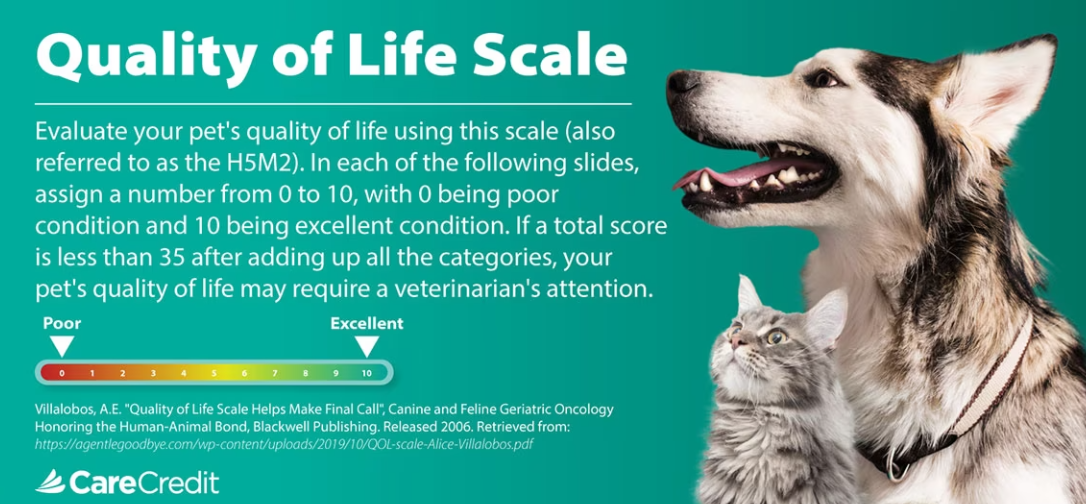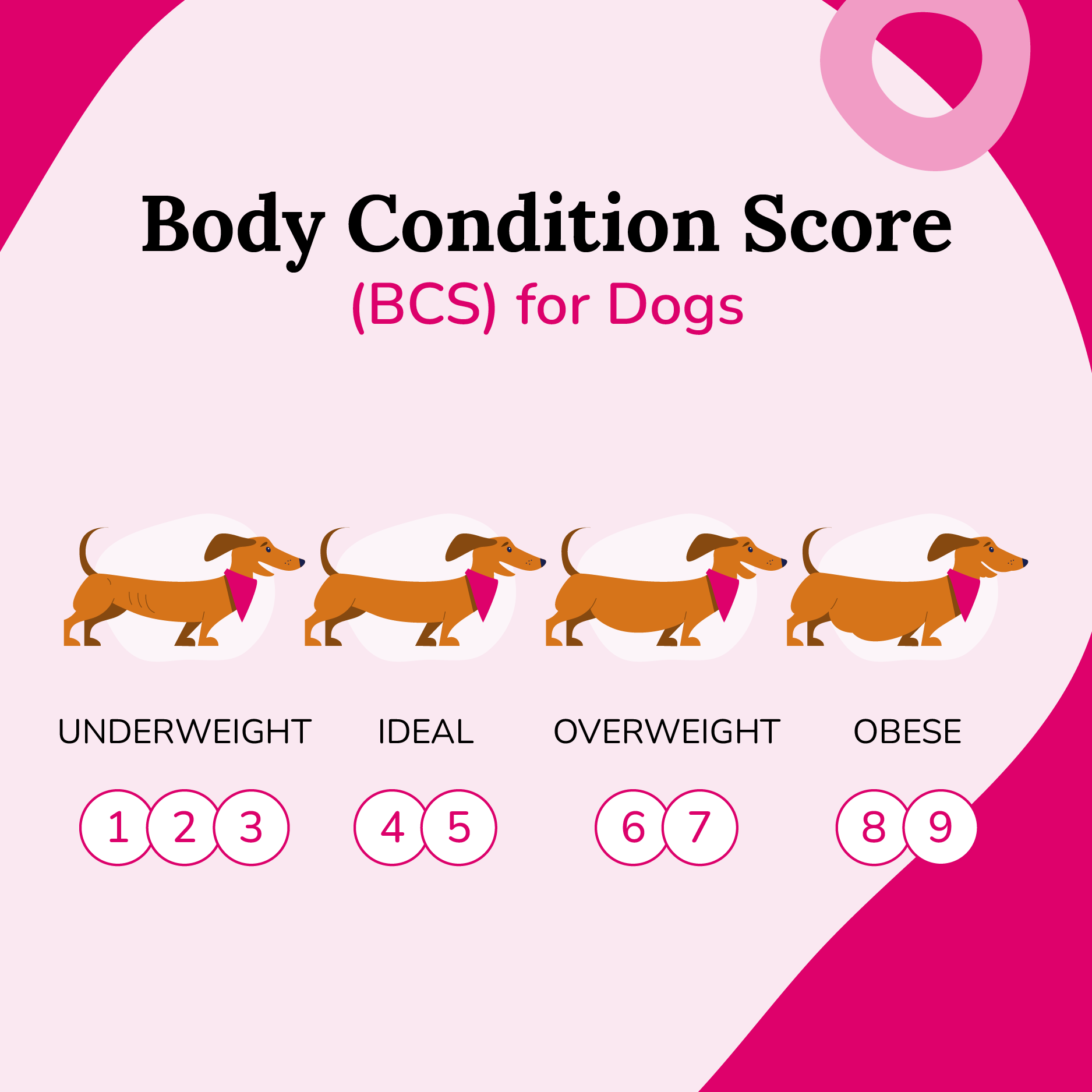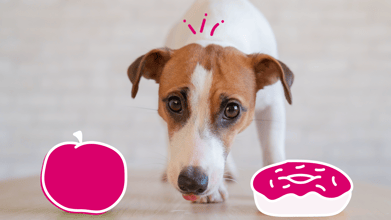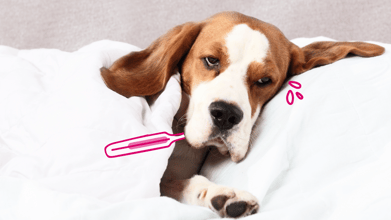Helping Your Pet Maintain a Healthy Weight

Table of Contents
Maintaining a healthy weight boosts your pet's energy, reduces disease risk, and may extend their lifespan. Weight gain can result from age, breed, health issues, feeding habits, overfeeding, calorie-rich diets, inactivity, and genetics. To manage weight, ensure regular exercise, balanced meals with proper portions, limit treats, and avoid table scraps. Consult your veterinarian for personalized advice.
In my practice as a mobile veterinarian, I often emphasize the importance of maintaining a pet’s healthy weight. Think of your dog or cat’s optimal weight and balanced nutrition as another preventative wellness tool, helping your pet to live a long and active life.
In this blog post, I'll guide you to understand the significant benefits of maintaining a healthy weight and some common causes of weight gain in dogs and cats.
I will also provide some helpful tips to keep your furry friend in tip-top shape.
Benefits of a Healthy Weight for Pets
Maintaining a healthy weight for your pet supports their overall health and well-being. Ensuring that they stay within a healthy weight comes with many benefits:
Prevention of obesity-related disease
Diabetes mellitus, early arthritis, cardiovascular diseases such as hypertension, respiratory problems, and gastrointestinal issues such as constipation and pancreatitis can be significantly reduced by maintaining a healthy weight.
1. Has your dog experienced rapid weight loss?
2. Has your dog’s appetite increased or decreased?
3. Is your dog more thirsty than usual?
4. Is your dog urinating more frequently than usual?
5. Is your dog less active than usual?
6. Does your dog have cloudy eyes or is experiencing vision problems?
7. Is your dog experiencing frequent urinary tract infections?
8. Does your dog have sweet-smelling breath?
9. Does your dog seem more lethargic than usual?
10. Does your dog have a family history of diabetes?
11. Is your dog's coat dull or thinning?
12. Has your dog had frequent skin infections?
1. Is your cat urinating more frequently than usual?
2. Is your cat more thirsty than usual?
3. Has your cat experienced rapid weight loss?
4. Is your cat showing signs of muscle weakness?
5. Has your cat’s appetite increased or decreased?
6. Does your cat seem more lethargic than usual?
7. Is your cat vomiting more than usual?
View Results
Greater mobility
Excess weight puts additional strain on the joints and musculoskeletal system, leading to reduced mobility and an increased risk of joint pain and arthritis.
Additionally, overweight pets are more susceptible to back injuries.
Increased energy levels
Pets at a healthy weight are more energetic, active, and more likely to engage in physical activity, leading to greater stamina and endurance for exercise, play, walks, hikes, swimming, and so on.
Better respiratory health
Dogs and cats at a healthy weight may have better respiratory health, too. Overweight or obese pets may demonstrate signs of respiratory distress when excited or going about daily routine activities.
There are increased respiratory risks and signs of difficulty on hot days, during exercise, or at times of stress.
Reduced risk of heat intolerance
Healthy pets can often tolerate heat better than overweight dogs and cats. Overweight pets may struggle to tolerate warmer temperatures and may be at higher risk of heat stroke.
Maintaining a healthy weight helps regulate body temperature more effectively.
Improved immune function
Pets at their ideal weight may also have better immunity against common illnesses. Evidence shows that pets carrying extra weight may be more susceptible to infections and other health conditions.
Improved Quality of Life
A healthy weight improves a pet’s quality of life, reduces the risk of chronic health problems, and supports daily exercise and activities.

Longer Lifespan
According to the American Veterinary Medical Association, excess weight can reduce a dog's life expectancy by up to 2 and ½ years compared to dogs at a healthy weight.
How to Know if Your Pet is at a Healthy Weight
In veterinary medicine, we use a scale called Body Condition Score (BCS). This scale is a quantitative yet subjective method for evaluating body fat and a pet’s body condition.
Is My Dog Overweight?
How to Use the Body Condition Score (BSC) Chart
- Feel Your Dog’s Ribs: Gently feel along your dog’s ribs and chest. An overweight dog will have excessive fat covering the ribs, making them more difficult to feel. An underweight dog’s ribs will feel more “bony” and prominent. If your dog is at a healthy weight, you’ll be able to feel the ribs, but only when pressing gently on them.
- Check Your Dog’s Abs: Get down on your dog’s level and look at your dog’s shape from the side. Check where their chest transitions to their belly. Ideally, this area should have a tapered appearance, called an abdominal “tuck.”
- Look at Your Dog’s Waistline: Look at your dog’s shape from above. Do they have a slightly tapered-in waistline? If so, this is one indicator that your dog may be at a healthy weight.
View Results
Is My Dog Overweight?
1-3 Underweight
A body condition score of 1-3 is generally considered to be too thin. Consult with your vet about introducing more calories into your dog’s diet and rule out any medical causes.
4-5 Just right!
A body condition score of 4-5 is an indicator that your dog is at an ideal weight. If you still have concerns, a vet can advise you best.
6-9 Overweight
A body condition score of 6-9 means that your dog may be overweight or obese. It’s important to check in with your vet about the best plan for your pet.
Share Quiz
Is My Cat Overweight?
Is My Cat Overweight?
1. Calculate your cat's current weight.
2. Take their PCL Measurement - a cat’s PCL is the length from the top of the patella (knee) to the end of the calcaneus (ankle). Make sure your cat is standing with their head upright and measure the length of your cat's lower back leg from the knee to the ankle.
3. Enter these two calculations below.
View Results
Your Cat’s BMI is
which means
Interpreting Your Results: What to Do if Your Cat is Underweight or Overweight
Keep in mind that our calculator is meant to serve as a general guide, and there could be a medical reason why your cat is either underweight or overweight. If your cat is not at an ideal weight, it is important to rule out a medical cause for this, so you should first check in with your veterinarian before making any changes.
Once your vet has determined that your cat’s non-ideal weight is not related to an underlying medical cause, you’ll want to work together to create a vet-approved nutrition plan. Your vet can make recommendations about the best foods for your cat, how much to feed them, and help to ensure that any nutrition changes will be healthy for them.
Share Quiz
Ranging from 1 to 9:
-
A score of 1 means emaciated and extremely underweight, while a 9 score means obese with an extreme amount of body fat.
-
Ideally, a score between 4 and 5 suggests an optimal weight, indicating a healthy balance of muscle and body fat.
The BCS allows veterinarians to evaluate each pet individually which is important as dogs and cats come in various shapes, sizes, and breeds, each with their own unique body structure and ideal weight range.

Reasons Why Your Pet Might be Overweight
In order to maintain your pet’s healthy weight, it is important to understand the underlying reasons, from age-related changes to medical conditions and feeding practices.
Here are the most common reasons your pet is overweight:
Age
Just like in people, metabolic rate may decline, leading to a decrease in energy expenditure and calorie requirements. Older pets burn fewer calories at rest and during physical activity.
Additionally, activity levels may decrease with age due to factors such as reduced mobility, joint stiffness, muscle weakness, or chronic conditions.
Breed
Certain breeds of pets may be more predisposed to obesity. Genetics, metabolism, body composition, and lifestyle can make some breeds more susceptible.
Moreover, some breeds have a stronger food drive than others, making it easier to overfeed them.
Medical Reasons
Medical reasons can cause weight gain in pets through processes that affect appetite, metabolism, energy balance, nutrient absorption, and fat storage.
Common medical conditions that can promote weight gain include hypothyroidism, Cushing’s disease, diabetes mellitus, arthritis, or other mobility issues.
Some medications used to treat chronic conditions can have side effects that contribute to weight gain.
Activity Level
Physical activity influences energy expenditure, metabolism, muscle mass maintenance, and calorie balance in pets. Engaging in activities such as walking, running, swimming, and playing increases calorie burn and boosts metabolism.
However, senior pets or those with chronic health conditions may have decreased activity levels, resulting in less energy expenditure and promoting weight gain.
Nutrition
-
Calorie intake: Consuming more calories than your pet expends through activity can lead to weight gain.
-
Dietary composition: Diets with higher fat and carbohydrates provide excess calories and promote weight gain.
-
Feeding practices: Free feeding or allowing pets to graze throughout the day can predispose some pets to weight gain. Additionally, feeding too much per meal and indulging in excessive treats, snacks, or toppers can also contribute to weight gain.
-
Food quality: The quality and nutritional adequacy of the diet can impact metabolism, weight, and overall health. Diets lacking essential nutrients can lead to nutritional deficiencies, metabolic imbalances, and overeating.
-
Life stage: Nutritional requirements vary depending on the pet's life stage and activity level, with kittens and puppies needing more calories than senior pets.
Nutrition for a Healthy Dog Weight
High-quality dog foods are formulated to meet your pet's nutritional needs based on their life stage, size, breed, and activity level. Look for a dog food with the following ingredients:
- Moderate fat content
- Lean protein sources like chicken, turkey, fish, and lean cuts of beef or lamb
- Controlled calorie formulas for dogs with chronic conditions, seniors, or reduced mobility.
Cat Nutrition for a Healthy Weight
High-quality cat foods are suited to your feline friend’s life stage, size, breed, and activity level. Choose a cat food that meets the following criteria:
-
Moderate fat content to support weight management in your cat.
-
Adequate high-quality protein source to maintain muscle mass and support overall health.
-
Controlled calorie formulas for cats with chronic conditions, seniors, or reduced mobility.
Activities to Manage Pet Weight
Ensuring your pets maintain a healthy weight goes beyond diet—it also involves keeping them active.
Here are the best activities for weight maintenance tailored to both dogs and cats
Activities for Dogs
Activities should be determined by your dog's life stage, breed, and physical ability. Set a regular schedule with daily activities like walks, swimming, running or jogging, fetch, agility training, hiking, interactive toys, playdates, and obstacle courses.
Activities for Cats
Daily activities are just as important for cats as they are for dogs and people, so incorporate interactive toys, vertical spaces, hide-and-seek, feather toys, fetch, tunnel play, and outdoor enclosures (catios) into their routine.
Tips for Weight Management in Pets
Here are more ways to make sure your pet is at a healthy weight:
Wellness exams
Regular wellness exams allow your veterinary care team to closely monitor and assess your pet's weight, body condition, and dietary requirements throughout their lifespan.
Nutritional consultation
Your BetterVet veterinarian will develop a personalized diet plan tailored to your pet’s individual needs, health status, and weight management goals.
Restrict table scraps
Table scraps add extra calories, so it’s best to avoid feeding from the table. If you have family members who just can’t help themselves, then keep the pets out of the dining area when eating.
Limit treats
While treats can be a great way to reward your pet and aid in training, it's important to limit them to avoid excess calorie intake. Remember to adjust your pet's meal portions if you're giving treats throughout the day.
Read food labels
Pet food labels provide details about ingredients and guaranteed analysis (percentage of nutrients). All pet food labels will tell you the calorie content (as kilocalories or kcal) of the food, either per cup or per can on the label.
Working with your veterinarian, you can determine the right amount of kilocalories (kcals) to feed your pet to meet their nutritional needs.
Conclusion
Monitoring your pet's weight and nutrition can add years to their happy life! Regular exercise, a balanced diet, and wellness checkups are key to maintaining a healthy routine.
If you have concerns about your pet’s weight or nutrition, schedule a nutritional consultation with BetterVet for a personalized plan to keep your furry friend healthy and happy.
Discover the Recipe for a Healthy Pet
Consult with one of our vets about your pet’s nutritional needs and long-term health.
Frequently Asked Questions
How can I get my cat to maintain a healthy weight?
Regular exercise, proper nutrition, portion control, wellness exams, and preventative healthcare contribute to your cat’s optimal weight.
How can you keep your pet healthy?
You can keep your pet healthy by ensuring they get regular exercise, proper nutrition, regular wellness exams, and preventative healthcare. Additionally, staying educated about your pet's dietary needs and understanding pet food labels with the help of your veterinarian will promote a long, healthy life.
What can I feed my dog to help gain weight?
There are diets available that are more calorie-dense. Your veterinarian can help you find the right food that meets the nutritional requirements needed to help your dog gain weight.
How much should a 20-pound dog eat?
The amount of food a 20-pound dog should eat depends on factors such as age, activity level, breed, and overall health. Take our quiz to start, and work with your veterinarian to determine the right amount of food for your unique pet.
Sources
-
Martha G. Cline, Kara M. Burns, Jason B. Coe, Robin Downing, Tiffany Durzi, Maryanne Murphy, Valerie Parker; 2021 AAHA Nutrition and Weight Management Guidelines for Dogs and Cats. J Am Anim Hosp Assoc 1 July 2021; 57 (4): 153–178. doi: https://doi.org/10.5326/JAAHA-MS-7232
-
Yam, P., Butowski, C., Chitty, J., Naughton, G., Wiseman-Orr, M., Parkin, T., & Reid, J. (2016). Impact of canine overweight and obesity on health-related quality of life. Preventive Veterinary Medicine, 127, 64-69. https://doi.org/10.1016/j.prevetmed.2016.03.013






